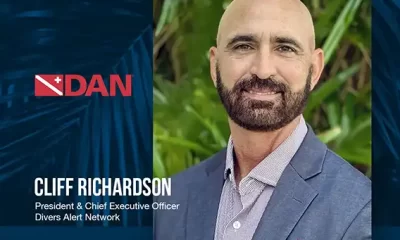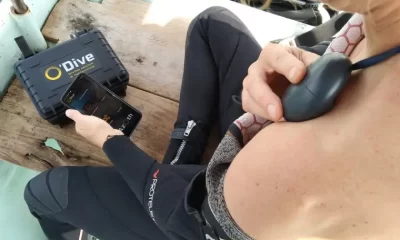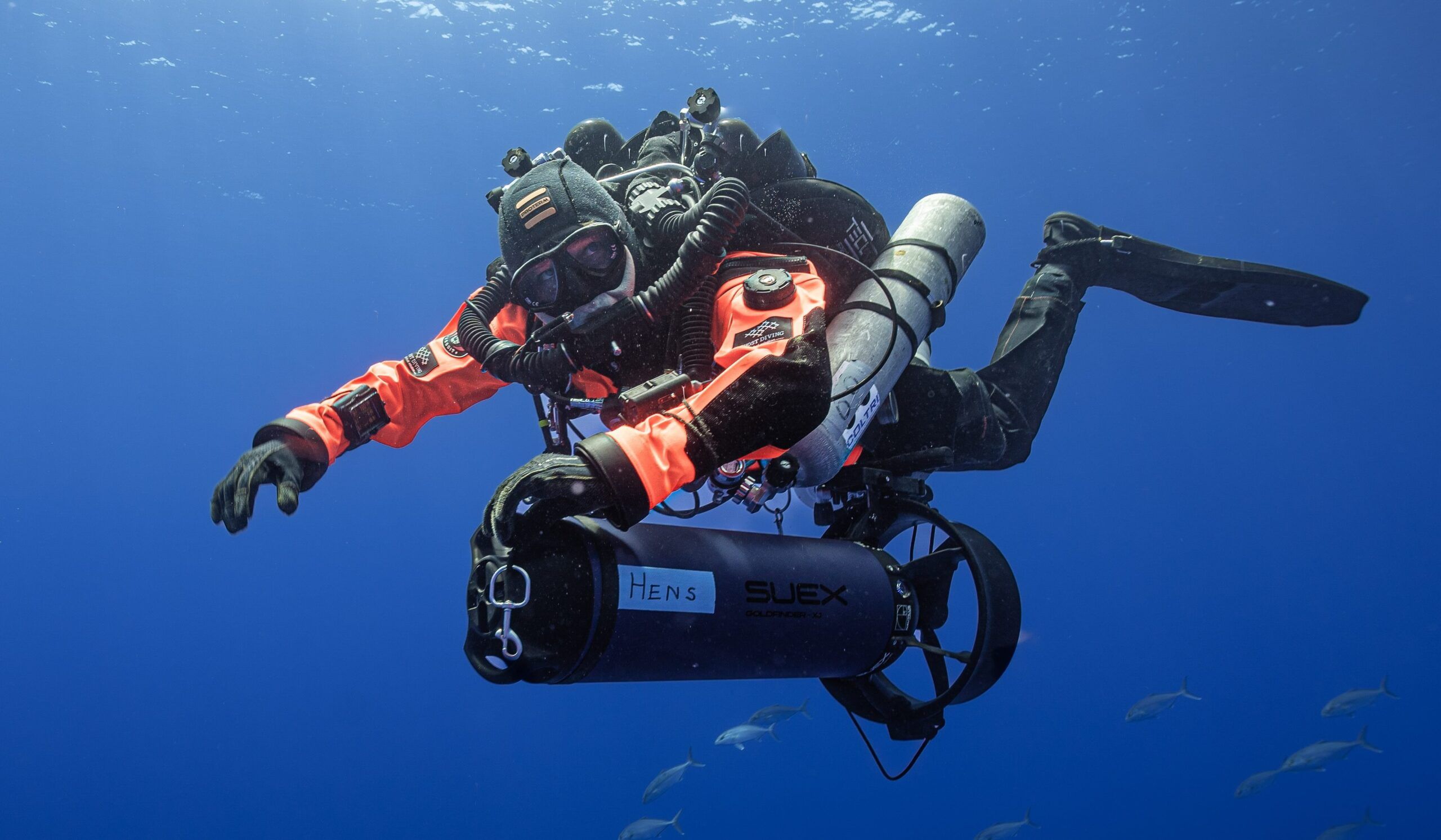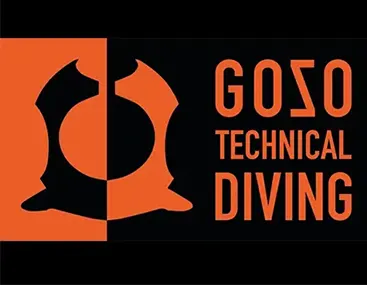Latest Features
Counting DecoBubbles: A Crowdsourcing Initiative For Diving Research
Frauke Tillmans and Virginie Papadopoulou and their team need YOUR HELP counting bubbles! Their goal: to develop an automated algorithm to detect and score venous gas emboli (VGE). It’s a new crowdsourced research initiative from Divers Alert Network (DAN) in collaboration with the Department of Biomedical Engineering at UNC Chapel Hill & NC State University. Welcome to Counting DecoBubbles.

By Frauke Tillmans and Virginie Papadopoulou
Header image courtesy of the authors
What do DAN researchers do during a pandemic with few diving opportunities? We put the final touches on our new diving research app, of course! The research team at the Divers Alert Network (DAN) and Department of Biomedical Engineering at UNC Chapel Hill & NC State University, together with a handful of collaborators worldwide, is proud to present DecoBubbles.com.
Venous gas emboli (VGE) are decompression bubbles that are detectable on ultrasound imaging in the blood of some divers for several hours after a dive. Higher loads of VGE are associated with a higher risk of decompression sickness (DCS), but the relationship is not linear. Differences in VGE and DCS risk have been documented among individuals and in the same individual—even with identical dives. Importantly, VGE evolution post-dive varies dramatically, so getting frequent measurements can help us study the influence of VGE on other physiological mechanisms in diving. Toward this goal, we are refining automated algorithms for VGE detection.
We have developed an online application where anyone can volunteer their time to help locate bubbles in post-dive echocardiograms. This will help us build robust machine-learning algorithms to automate this task and accelerate the pace of decompression research to improve our understanding of how these bubbles are related to decompression sickness and human physiology.
This project has also provided training opportunities for the numerous students involved at various stages of the research development. Read on to learn about the first “dive into research” on the part of our lead developer Martin Smolka, a computer science senior at UNC! And be sure to register here to start counting bubbles: DecoBubbles.com.
Creating a Crowdsourcing Research Tool
By Martin Smolka
I am a senior at UNC Chapel Hill where I am finishing my bachelor’s degree in computer science. A year ago, a friend forwarded an email to me about a diving lab that was looking for someone to build a website. I uttered the famous last words, “How hard can it be?”, and sent over my resume.

Looking back, after working with this team for more than a year now, I find it funny how quickly I found myself in over my head. To this day, the closest I have ever been to diving was when I was 10 years old and angry that the deep end of the local YMCA pool was closed off for diving training. Combine this with the rude awakening that completing a three-month internship at a tech company does not automatically make me an expert web developer, and you can see my dilemma.
The one thing I did have going for me was that I knew so little, I never knew how in over my head I truly was at any given time. Now, a year later, I am happy to announce that the website is live on Decobubbles.com. Building this site has been the most difficult and most rewarding aspect of my journey to earn my undergraduate degree.
Decobubbles.com is the latest chapter in my team’s story to personalize decompression procedures. Currently, decompression procedures are successful at reducing the risk of decompression sickness (DCS); however, they follow a one-size-fits-all approach, and cannot predict if an individual diver is likely to develop DCS. While two divers can make the same dive and follow the same decompression procedures, one may develop DCS, and the other will not.
DCS results from decompression bubbles growing during and after the diver ascends to the surface, but the majority of divers with bubbles do not develop DCS. My team, known as “Team Scuba” around the biomedical engineering department, in collaboration with DAN, researches these bubbles and is currently optimizing their detection using ultrasound imaging. Ultrasound imaging is widely used in diving research to detect circulating bubbles post dive; the VGE appear as bright spots moving through the chambers of the heart. We are researching these bubbles because we believe that they can help personalize decompression procedures.
To study how divers’ physiology responds to dives, we collect multiple ultrasounds of divers’ hearts (echocardiograms or “echos”) for several hours post dive. The reason we take so many echoes is because the amount of decompression bubbles, aka decobubbles, can vary dramatically over time and the dynamics of those changes could offer new information for our research.
Collecting each echo is relatively easy and takes less than a minute; however, determining how many bubbles are present in an echo is more complicated. While this is a pretty simple process for medically trained personnel, it is difficult to get a cardiologist to review the thousands of ultrasounds one of our experiments can produce. So, Team Scuba began to focus on ways to streamline the process of determining how many bubbles are present in echos.

I’m Forever Counting Bubbles
The process of “bubble counting” was developed to easily quantify bubbles on echocardiography. Bubble counting can be done by anyone with relatively little training. While easier, bubble counting started out much slower, taking well over eight minutes to count a 20 second video by hand. This process now takes around three to four minutes thanks to a previous undergraduate student’s work building a computer interface that automates many of the time-consuming aspects of the method. This program has greatly increased the volume of data a given research team can analyze in the context of their own experiments, but is not ideal for sharing the analysis of a large amount of data between people located in different parts of the world.

This is where my chapter of the story begins. I was brought onto the team to bring the echo rating program to the web for easy sharing and crowdsourcing. Starting out, while I was very excited about working on this project, I was even more excited at the prospect of not being completely broke on the weekends. Then, when I began to start researching what would be necessary to pull off this task, the weight of the task started to crush a good portion of the initial excitement.
What makes this website much more complicated than the previous rating program is that everything needs to be done through the cloud. Whereas many things, like determining what video to show the rater, and determining who could use the program, were trivial on the old program, I would now have to design systems to run on the cloud to accomplish these tasks. I had never attempted to build systems as complicated as these before, and I had no idea where to even begin. I would spend many hours with a pen and paper just drawing out the process behind the systems, and eventually I would think I had a winner. Then I would spend the next few days implementing the idea and spend the next month finding all the little bugs and mistakes in my strategy. Creating Decobubbles.com was a slow and tedious process, so I am ecstatic that it has finally come together.
While I spent countless hours learning and implementing new technologies, the most difficult thing by far was creating the tutorial. This was not only difficult for me technically, but also difficult conceptually. It took me a long time to create a system to train and test new raters; however, it took me much longer to actually create the tutorial video.
When I started creating the tutorial, I naively thought I was a bubble counting expert since I spent hours glancing at echos while I was building the website. I quickly figured out that being able to make out a few bubbles on an echo and having the knowledge to teach someone how to rate an echo were two separate things
When I started creating the tutorial, I naively thought I was a bubble counting expert since I spent hours glancing at echos while I was building the website. I quickly figured out that being able to make out a few bubbles on an echo and having the knowledge to teach someone how to rate an echo were two separate things. I find it very funny that my process to learn how to rate an echo was creating a tutorial to teach others how to rate echos. This had one big benefit, however. I knew what aspects would be confusing to new raters because those aspects were still confusing to me. Then I was able to take those confusing aspects and explain them further in a way that even I, a complete novice, would understand. All in all, I am very happy with how the tutorial turned out and glad to have learned so much through the process.

The story of personalizing decompression procedures did not start with me; nor will it end with me. In the next chapter, the team will pull the data generated from decobubbles.com to train an artificial intelligence (AI) to automate the echo rating. Automated echo rating would mean that the team can conduct experiments while no longer constrained by the capacity of echo rating and will be able to generate more data than ever before. This data will become a major part of our larger goal to target decompression procedures to individual physiology and could eventually be loaded onto dive computers as personalized algorithms. AI might even be used again to aid in this task because of its ability to find patterns and correlations in large and complex datasets!
My contribution to this story is quickly coming to an end as the days until my graduation continue to count down. After I graduate, I plan to get a job using the skills I have developed working on Decobubbles.com by writing software. The research environment allowed me to take extra time to learn new technology and to develop as a programmer.
One great way to learn about echocardiography and aid in research is to log onto decobubbles.com. Each rating that you submit will aid our efforts to better understand DCS and produce personalized decompression procedures.
One great way to learn about echocardiography and aid in research is to log onto decobubbles.com. Each rating that you submit will aid our efforts to better understand DCS and produce personalized decompression procedures. So, help me end my project on a high note by checking out Decobubbles.com today!
Funding:
This crowdsourcing project is funded by the Divers Alert Network (grant #DAN-UNC-1), and analyzed data is being fed into the collaborative project, “Automating the detection of post-dive venous gas emboli” funded by Department of the Navy, Office of Naval Research (grant #N00014-20-1-2590), bringing together DAN, UNC, Duke and UCSD.
References:
Nishi RY, Brubakk AO, Eftedal OS, Bubble detection, in Bennett and Elliott’s physiology and medicine of diving, A.O. Brubakk and T.S. Neuman, Editors. 2003, WB Saunders: Philadelphia, PA. p. 501-29.
Eftedal OS, Lydersen S, Brubakk aO. The relationship between venous gas bubbles and adverse effects of decompression after air dives. Undersea and Hyperbaric Medicine, 2007. 34(2): p. 99-105.
Papadopoulou V, Eckersley EJ, Balestra C, Karapantsios TD, Tang MX. A critical review of physiological bubble formation in hyperbaric decompression. Advances in Colloid and Interface Science, 2013. 191-192: p. 22-30.
Le DQ, Dayton PA, Tillmans F, Freiberger J, Moon R, Denoble P, Papadopoulou V. Ultrasound in Decompression Research: Fundamentals, Considerations, and Future Technologies. Undersea and Hyperbaric Medicine. 2021;48(1):59-72.
Markley E, Le DQ, Germonpre P, Balestra C, Tillmans F, Denoble PJ, Freiberger JJ, Moon RE, Dayton PA, Papadopoulou V. A fully automated method for late ventricular diastole frame selection in post-dive echocardiography without ECG gating. Undersea and Hyperbaric Medicine. 2021;48(1):73-80.
Papadopoulou V, Germonpre P, Cosgrove D, Eckersley RJ, Dayton PA, Obeid G, Boutros A, Tang MX, Theunissen S, Balestra C. Variability in circulating gas emboli after a same scuba diving exposure. European Journal of Applied Physiology, 2018. 118(6): p. 1255-1264.
Papadopoulou V, Tillmans F, Denoble P. Call for a multicenter study on the intra-subject variability of venous gas emboli. Undersea and Hyperbaric Medicine, 2017. 44(5): p. 377.
Vann RD, Butler FK, Mitchell SJ, Moon RE. Decompression illness. Lancet, 2011. 377(9760): p. 153-64.
Sawatzky, K.D., The relationship between intravascular Doppler-detected gas bubbles and decompression sickness after bounce diving in humans, 1991, York University: Toronto, ON.
Papadopoulou V, Lindholm P. An Echo from the past; building a Doppler repository for big data in diving research. Undersea and Hyperbaric Medicine. 2021;48(1):57-58.
Dive Deeper:
Here are some of the DAN research projects in the works:
Comparative Testing of Ultrasound Devices in Monitoring VGE
Exploring Decompression Bubbles Using Advanced Ultrasound Techniques
InDepth: Retired French Naval officer Axel Barbaud and his team have developed an automated bubble scoring algorithm for doppler readings: Oh Deco, Oh Doppler, O’Dive: Assessing the World’s First Personal Deco Safety Tool
InDepth: Everything You wanted To Know About PFOs and Decompression Illness, But Were Too Busy Decompressing to Ask by Dr. Doug Ebersole

Dr. Frauke Tillmans is the Research Director at Divers Alert Network (DAN). She has a PhD in Human Biology and oversees DAN’s research initiatives in injury monitoring and diving physiology, including acute diving injuries, as well as long-term health effects of diving and extreme exposures. Throughout her career she has participated in projects covering a variety of medical aspects in recreational and military diving. An avid and well-travelled diver herself, she has become DAN’s point of contact for global scientific collaborations, including the newest addition, “DecoBubbles”.

Dr. Virginie Papadopoulou is a Research Assistant Professor in the Joint Department of Biomedical Engineering at the UNC Chapel Hill & NC State University. Her research aims to bridge the different areas dealing with bubbles in the bloodstream, from environmentally triggered endogenous bubbles, to engineered contrast agents for ultrasound imaging and therapy. She has been awarded the 2017 Divers Alert Network/Bill Hamilton Memorial Grant by the Women Divers Hall of Fame, the 2020 Undersea and Hyperbaric Medicine Young Scientist Award, as well as the title of Divers Alert Network Scholar since 2018, for her on-going work creating a dynamic ultrasonic assessment of decompression bubbles.

Martin Smolka is a Senior at The University Of North Carolina at Chapel Hill where he is finishing up his bachelor’s in computer science. Martin has experience with building modern web applications and works as an undergraduate researcher on Dr. Papadopoulou’s team to build and maintain DecoBubbles. He designed and developed the application using Google’s Angular Framework and developed the structure of the database in Firebase.



















































